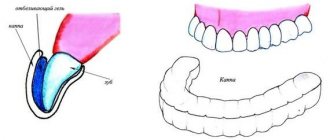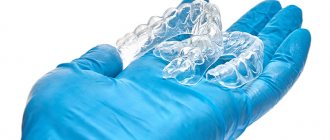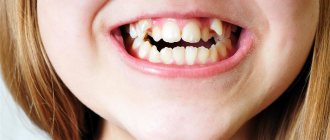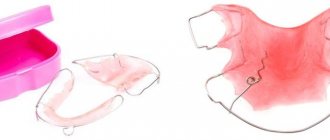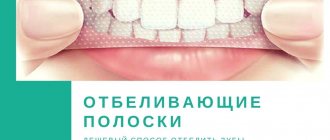Enamel is the hardest tissue in the body. Its density is determined by the minerals it contains. When their quantity decreases, the enamel loses its properties, quickly collapses, and the patient complains of sensitivity to hot and cold. Remineralizing therapy in dentistry allows you to restore hard tissues and prevent the development of caries.
| Prices for remineralizing therapy | |
| Remineralizing therapy (for 2 jaws) | 3200 R |
What is a dental guard?
In modern dentistry, there are many types of mouth guards, differing in their purpose.
With its help, it can protect teeth, promote their alignment, whiten and strengthen tooth enamel. A mouthguard is a removable device, i.e. a dental cover made of transparent material that covers the entire dentition. A dental mouth guard can be used to protect teeth during times of increased stress, such as during sports, to whiten teeth, straighten teeth, and reduce stress on the jaw.
The principle of operation of the cap is mechanical pressure on areas requiring correction. Each tooth is located in a specific socket and is surrounded by connective tissue that holds it in place. If constant pressure is applied to it, over time the tooth will change position.
Enamel composition, imbalances
The main chemical elements that form tooth enamel are calcium and phosphorus. Poor nutrition, changes in pH in the oral cavity, active proliferation of bacteria, and changes in the composition of saliva lead to a decrease in the concentration of microelements. This leads to tooth decay and the need for dental treatment.
Factors provoking demineralization:
- diseases of the digestive system;
- lack of microelements in the diet;
- accumulation of food debris, plaque formation;
- inflammation of soft tissues;
- poor dental care;
- smoking, excessive consumption of tea, coffee;
- destruction of enamel under the influence of mechanical factors;
- decreased immunity;
- hormonal disorders;
- simultaneous consumption of cold and hot foods and drinks;
- elderly age;
- lack of calcium and phosphorus during pregnancy, active skeletal growth in a child.
Types of mouth guards
Silicone mouth guards for athletes
Sports or protective mouthguards are designed for those who play contact sports such as hockey, football, boxing or prefer extreme recreation. These mouthguards on the front teeth help reduce the mechanical impact on the jaw and prevent damage not only to the teeth and soft tissues of the face, but also to the cervical spine.
There are two types of protective sports mouth guards:
- standard mouth guard - made according to a single sample and completely ready for use;
- custom mouth guards - made from biopolymers based on personal impressions, which allows you to reproduce all the structural characteristics of the dentition.
Orthodontic aligners
These are structures for aligning the dentition, made according to individual impressions of the patient’s jaws. Unfortunately, not all of these bite-correcting mouthguards are able to cope with serious malocclusions. They are mainly effective in eliminating interdental spaces and correcting some malocclusion pathologies. However, when it comes to Invisalign® orthodontic aligners, they can easily be considered as an alternative to braces.
Mouth guards for teething
There is another type of dental aligner: trainers. They are also called teething guards, teething guides or LM activators. Various models of this type of mouthguard are made of silicone. They are available in different sizes. Despite the name, teething protectors are actually used to correct the jaw relationship and align the incisors in children between the ages of 6 and 10 years, which is the early stage of malocclusion. How long to wear the aligners? The child needs to wear the mouthguards for several hours, day and night. The treatment period is usually about one year with periodic monitoring of intermediate results based on impressions of the jaws taken at various stages of correction.
Teeth whitening trays
If you want to achieve a genuine smile, but for some reason in-office whitening procedures are not an option for you, you can make your teeth whiter at home with professional systems using a custom, standard or disposable thermoplastic dental tray whitening gel. However, if this is the case, you will still need to visit your dentist to take an impression and make your own mouth guard or simply learn how to use a mouth guard. At the same time, be prepared for the fact that the whitening process using this technology will be slow and will take at least a month, since the percentage of hydrogen peroxide in the gel is lower than in office whitening systems. But this method is considered most suitable for teeth with increased sensitivity.
How to wear a teeth whitening tray at home? First you need to brush your teeth, apply the gel inside the tray and put it on, pressing lightly so that the gel is evenly distributed. Next, you need to rinse your mouth and put on the mouth guard for the time specified in the instructions. Then remove the mouthguard and rinse your mouth with water again.
Dental mouthguards
Dental mouth guards are also used for remineralization procedures. A special gel or paste is applied to the inner surface of the mouthguard and pressed tightly against the teeth. Regular use of a device filled with a mineralizing composition can effectively strengthen and restore tooth enamel. These mouthguards come in standard and thermoplastic varieties. A thermoplastic dental tray is made of a flexible material that softens when immersed in hot water. After this, it is immediately applied to the teeth and the material hardens.
Methodology
The purpose of the procedure is to normalize the balance of microelements and restore damaged areas. This prevents tooth decay, the development of caries, and increases resistance to harmful influences.
The technique is based on applying special preparations containing microelements to the teeth: calcium, phosphorus, fluorine, zinc. The procedure takes place in several stages:
- removal of hard and soft deposits;
- treating the surface of teeth with hydrogen peroxide;
- drying the surface;
- applications of remineralizing drugs;
- applying a protective layer containing fluorine.
To increase efficiency and improve the penetration of components into the enamel, electrophoresis or phonophoresis is used.
When fluoridating teeth, the composition is applied with a brush or placed inside special trays that are placed on the jaws.
After the procedure, you need to refrain from eating and drinking for 2-3 hours. This is necessary for the drug to penetrate into the thickness of the enamel.
Indications and contraindications for the use of mouth guards
Effective results are achieved with mouth guards only if they are used according to the wearing instructions. There are the following indications for which aligners should be used as part of orthodontic treatment:
- too large spaces between teeth (gaps);
- crowding, curling of teeth;
- enlarged or narrowed dental arch;
- as the final stage of using braces (instead of retainers).
- whitening effect.
Mouthguards correct slight crooked teeth, while they are completely invisible when worn, they can also be temporarily removed and then fixed again. If the patient is forced to hold an important event, a business meeting, such mobility of this product can greatly facilitate negotiations. The patient can remove this medical device for a couple of hours and then put it back on.
An interesting method of whitening with caps was developed by doctors who began to use this product together with special whitening pastes saturated with fluoride and potassium, which help reduce tooth sensitivity. In addition, the composition of the whitening paste itself may vary depending on the degree of yellowing of the teeth. This procedure is not a panacea for all patients. This method requires medical supervision. It has a number of contraindications. It means:
- allergic reactions to the components of the whitening paste;
- age less than 18 years;
- gum disease and some dental problems;
- wearing earrings in the lip area (piercing).
Mouth guards can only be used for minor defects in the dental system that lead to disruption of the aesthetics of the smile. An orthodontist will not prescribe the use of caps for severe bite deviations, since in this case the treatment will not be able to bring a positive result.
Do mouthguards help straighten teeth?
In search of a means to correct dentition, many people wonder whether straightening teeth with mouth guards will bring the expected effect. Their fears are related precisely to the wrong choice of caps, which does not lead to the expected result. Remember: only specially designed mouth guards made according to your impression right in the clinic are suitable for correcting your bite and straightening your teeth. Sports masks, whitening or remineralizing masks are not intended for this! In addition, there are a number of rules that must be followed when wearing a mouthguard, otherwise you will not benefit from all their benefits.
How to wear a dental mouthguard correctly
Depending on the structure of the jaw and the recommendations of the orthodontist, a dental guard can be worn:
- Constantly (20-22 hours a day, taking off just to eat and brush your teeth). This method is chosen if it is necessary to correct the bite, eliminate diastemas, or correct the position of the teeth relative to each other. It is completely safe, even aesthetically pleasing: many celebrities constantly wear transparent aligners - they are practically invisible.
- Only for the night. This applies to dental night guards, which are prescribed to maintain the effect achieved by the appliance when the bite has already been aligned and only need to be maintained.
The mouthguards are very easy to use: they are easy to put on and easy to remove without assistance. To care for them, just clean them with a regular toothbrush and rinse well with water. In addition, mouthguards should not be used to chew gum or eat other foods that stick to the teeth (taffy, butterscotch).
To check the evenness of your bite, you need to visit your dentist every 2-3 months. The doctor will determine how long to wear the mouth guard - typically, the duration of wearing the mouth guard is 3 years or more.
Advantages and disadvantages of caps
Wearing this orthodontic design provides the patient with a number of advantages:
- made of transparent material and invisible to others;
- These are removable devices that allow for complete oral hygiene and food intake;
- in the manufacture of caps, hypoallergenic and safe materials for enamel and mucous membranes are used;
- do not cause speech impairment;
- period of rapid adaptation;
- copes well with bite problems in children and is actively used in pediatric orthodontics;
- easy to care for during daily hygiene procedures, does not require special detergents or special cleaning methods;
- works well in complex therapy in the treatment of teeth grinding and bruxism.
The disadvantages include:
- does not correct serious malocclusions;
- the time of using the mouth guard is controlled by the patient himself, so the result largely depends on his conscientiousness;
- The aligner does not correct serious defects - crowded teeth, severe curvature;
- the high cost of some types of hats.
Indications
Remineralization for preventive purposes is often carried out in childhood, starting from 6 years. This therapeutic procedure serves as a prevention of caries, which often affects fragile teeth. For adults, the procedure is recommended after removing hard deposits, removing orthodontic structures, and whitening. It is also carried out during pregnancy, lactation, and for dental anomalies.
For medicinal purposes, remineralization is indicated for caries in the stain stage, increased tooth sensitivity, with objective signs of decreased calcium and phosphorus levels, mechanical damage, impaired mineral metabolism in the body, congenital hypoplasia, and fluorosis.
Care of mouth guards
The orthodontic product must be kept clean; the effectiveness and duration of treatment largely depends on this. Patients themselves remove and apply the patch and check hygiene.
How to properly care for your aligners:
- the structure is cleaned daily with toothpaste and a toothbrush, rinsed with running water;
- inserts are regularly inspected for damage and wear; it is not recommended to wear a defective mouthguard;
- in case of breakdown, the patient is provided with other replacement models or the patch is remade;
- after each removal of the cap, rinse under running water to remove bacterial plaque from the surface;
- During the period of teeth straightening, it is not recommended to smoke or use chewing gum;
- The removable model is stored in an individual container with special perforations for ventilation.
Mouthguards for correcting bites can be an independent treatment measure or part of complex therapy. The use of such pads does not cause discomfort and does not require changes to your usual lifestyle and feeding. The treatment has no side effects, its adequacy is determined by a qualified orthodontist.
Result
The price of the procedure depends on the technique and medications. The doctor will select the optimal remedy after assessing the condition of your teeth. Remineralization requires additional investment, but in the future it will save on treatment.
Remineralizing therapy before and after photos.
Remineralizing therapy serves not only as a means of caries prevention. A set of procedures allows you to successfully treat caries at the spot stage without drilling. The effect is not noticeable immediately, but after the course of treatment, patients note an improvement in the appearance of their teeth and a decrease in their sensitivity. It has been proven that regular procedures can prevent tooth decay.
To improve the effect, you need to eat right, treat diseases of the digestive and endocrine systems in a timely manner, give up bad habits, and properly care for your teeth.
Preparing for treatment with mouth guards
Before starting treatment with an orthodontist, it is necessary to eliminate inflammation in the oral cavity, cure caries and remove decayed teeth. A mandatory step is professional hygiene, removal of tartar and plaque, and teaching the patient the rules of oral hygiene. Main stages of preparation for treatment:
- conducting diagnostic studies, studying the results of radiography, CT, photographing the initial situation in the oral cavity;
- creation of three-dimensional models of jaws;
- manufacturing of mouth guards according to a specific program of tooth movement;
- Explaining to the patient all the details of the process, coordinating all issues.
The aligner works slowly, so be patient to achieve the cosmetic results you desire.

